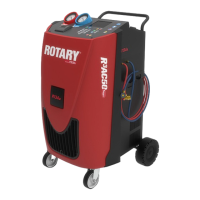4 SAFETY RULES
The technology used for the design and production control of the R
3
AC50 charging stations make
them simple, reliable and safe to use.
The personnel in charge of using the R
3
AC50 charging stations are required to follow the general
safety rules, use the charging stations for their intended use only and keep them properly, as
described in this manual.
All the requirements based on the following must be assessed and applied:
•
Labor inspectorate.
•
Trade associations.
•
Vehicle manufacturers.
•
Anti-pollution regulations.
4.1 Intended Use
Product Intended Use
R
3
AC50
charging and servicing A/C and climate control systems on cars, trucks and tractors.
4.2 Glossary
•
Equipment:R
3
AC50
•
Operator: qualified individual in charge of using the equipment.
•
External cylinder: new cylinder for refrigerant R134a used to fill the internal tank.
•
Cycle: the carrying out of single phases.
•
Operating phase: the carrying out of a single operation by the equipment (i.e. recycling).
•
Non-condensable gas: air accumulated during the vapor phase in the refrigerant, extracted
from the A/C system or from the tanks.
•
UV tracer injection: introduction of UV tracer into the A/C system in order to check for leaks.
•
Oil injection: introduction of oil into the A/C system in order to restore the correct quantity
recommended by the manufacturer.
•
Operator: qualified individual in charge of servicing air conditioning systems using a charging
station.
•
Recovery: removal of the refrigerant from the A/C system and the subsequent storage in the
internal tank, without the need for analysis or treatment.
•
Refrigerant: a liquid capable of vaporizing (R134a).
•
Recycling: reduction of the contaminants in the refrigerants used by separating the oil,
removing the non-condensable gases and passing the refrigerant once (or multiple times)
through elements that reduce the humidity, acidity, etc.
•
Refilling: refrigerant charging phase; it charges the A/C system with the amount of refrigerant
recommended by the manufacturer.
•
Internal tank: tank for storing the refrigerant.
•
A/C system: air conditioning or climate control system.
•
Disposal of the equipment: removal of the refrigerant destined to be stored in order to be
disposed of later (destroyed or transferred to waste disposal plants).
•
Vacuum: the evacuation of non-condensable gases and humidity from the A/C system
exclusively through a vacuum pump.
7

